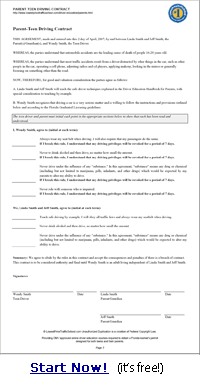Tag Archive: driver training

Driver Education: Teens and Defensive Driving
May 20, 2009
Teens are often urged to “drive defensively.” This is an excellent suggestion for any driver and is of particular importance to new drivers, who have limited experience in dealing with emergency situations and who are developing driving habits they may have for the rest of their lives. But what is defensive driving, exactly?
Driving defensively means driving in such a way that you reduce the risk of a crash, which will in turn prevent injury to yourself and others. It means going beyond following the rules of the road to put safety first. For example, if another driver is supposed to yield the right-of-way to you but fails to do so, as a defensive driver you will yield the right-of-way to that driver to avoid a collision.
Defensive driving isn’t just important in emergency situations, however. Using defensive driving techniques will help you:
- manage stressful driving conditions
- avoid traffic tickets
- keep your vehicle in good mechanical condition
- keep your driver’s license
There is no doubt that driving can be stressful, especially when traffic is heavy. One element of defensive driving is to maintain an adequate following distance from the vehicle in front of you. This decreases the risk of a rear-end collision if the vehicle ahead stops suddenly. Other ways to manage stress by driving defensively include:
- driving at a speed that is appropriate for conditions (which may be lower than, but is never higher than, the posted speed limit)
- checking intersections for cross traffic when you have a green traffic light (in case another driver runs the red light or a pedestrian is in the crosswalk)
- keeping a space cushion on all sides of your vehicle so you have room to maneuver if necessary
- watching the road ahead of your vehicle and checking your mirrors every three to five seconds so you notice hazards before they become a problem
Avoiding traffic tickets is especially important to drivers who are subject to a Graduated Driver’s Licensing program; these programs often restrict advancement to the next stage of licensure unless very few or no points accrue on the teen’s license. Traffic violations also mean hefty insurance increases for young drivers, who are already paying high rates because they are in a high-risk category. But following the rules of the road only when you’re worried about getting a ticket is not sufficient; if you’re not concentrating on driving defensively, you’re likely to make mistakes due to your reduced level of alertness. These mistakes could result in a ticket or even a crash, and even a minor fender-bender can result in points on your driving record.
Part of defensive driving is making sure that your vehicle is in good mechanical condition. Don’t wait for a breakdown to get your vehicle checked out; your owner’s manual offers a schedule of suggested maintenance tasks. Tires with low air or worn tread reduce your traction and make skids more likely. Your brakes need to be in top condition at all times. Even something as simple as not having windshield wiper fluid in the reservoir can impair your visibility and increase your chances of a crash. Don’t just put gas in the car and drive; take responsibility for ensuring that your vehicle is ready for the road.
As you’ve probably learned from your driver handbook, having a driver’s license is a privilege, not a right. This means that your driver’s license can be taken away, including for some non-driving offenses.
Driving defensively is part of an overall pattern of responsible behavior that will help you keep your license and the increased level of independence that comes with it.

The Importance of a Safe Driving Attitude
May 15, 2009
One important aspect of driver training is the development of a safe driving attitude. The reason a safe driving attitude is so important is because you will make many choices as you drive, and your driving choices have consequences. There are many benefits to a safe driving attitude, including:
- limiting stress while on the road
- saving you money on tickets and increased insurance costs
- helping you keep your driver license
- reducing your chances of being in a crash
To have a safe driving attitude, you must have control of your emotions and behavior, practice defensive driving techniques, and accept responsibility for all of your driving decisions.
Emotion is a word used to identify feelings such as anger, fear and joy. If you allow them to, emotions can change the way you assess risk and make driving decisions. When strong emotions such as anger affect you, your ability to make wise decisions may be reduced, increasing your chances of making a mistake. You may be so preoccupied with your anger that you misjudge the risks involved or don’t even notice important events in a particular driving situation.
Always be aware of your state of mind. Look at yourself objectively and decide if you really have the focus and alertness you need to safely use a motor vehicle. If you have any doubt, wait. Give yourself time to calm down and concentrate on safe driving. Learn more about how to avoid a road range incident.
You can expect some emotional stress in your everyday driving. Learning to manage it is important for your safety and the safety of others:
- If you are angry and excited, take a short walk, write your feelings down or talk to a friend before you get behind the wheel.
- No matter what is going on in your life, when you get behind the wheel, make a decision that until you arrive safely at your destination, you will focus on driving.
- Always allow plenty of time to get to your destination so you won’t get impatient with red lights or heavy traffic.
- Realize that many aspects of driving, such as heavy traffic and the actions of other drivers, are beyond your control. Stay calm when faced with stressful road conditions.
Part of having a safe driving attitude is consistently practicing defensive driving techniques:
- Make sure your vehicle is properly maintained
- Wear your safety belt and make sure your passengers do the same
- Choose a speed appropriate for conditions
- Make sure you have a space cushion all around your vehicle whenever possible
- Be alert and aware of the actions of all other road users, including motorcyclists, bicyclists, and pedestrians
- Watch the road ahead, behind and on both sides of your vehicle
- Anticipate problems early and select the best course of action in case the worst happens
- Give other drivers the benefit of the doubt when they make mistakes
Accepting responsibility for our decisions is an important part of becoming an adult. Willingness to do so demonstrates maturity and trustworthiness. When you drive, you must make sure you are willing to accept responsibility for all of your driving decisions. Other drivers cannot make you behave in one way or another; your reactions to their behavior are within your control. You must discipline yourself to put safety first no matter what any other driver does.
Developing a safe driving attitude is an important component of driver training; doing so from the beginning of your driving career will help keep you and others out of harm’s way on the road.

Driving Simulation Course a Great Tool for Better Driving
July 24, 2007
There’s a new course called Tragedy Prevention whose sole goal is to educate drivers about the dangers of the road in the hopes that accidents could be prevented. This is an excellent tool for not just reckless adult drivers who need driver’s education training, but also for new teenage drivers who need to be acclimated to the ways for the road.
Book learning in driver’s education can only take teens so far. Practical experience driving the roads definitely helps but they also need to experience potential dangerous situations so that they can anticipate their next moves and possible avoid a fatal accident. This Tragedy Prevention course is definitely a step in the right direction.
While this course is geared toward reckless drivers who may have had privileges suspended, there is also a special WHEELS program geared just for teens that is filling the driver’s education need since so many high schools are no longer offering the courses. What is so great is that teenagers are put through the paces in a simulator with different situations such as a tire blowout, driving at night or even dangerous weather conditions.
Typically, a teenager will not usually experience this in a real life training situation. However, at some point in their young life, these situations may happen. And without the proper guidance and anticipation of a solution, these teens could die in an accident. The purpose of Tragedy Prevention is to ensure that these teens understand the different dangers on the road and that sometimes, they themselves are the problem.
This training class shows teens through various simulations exactly what happens if they become distracted by cell phone texting or even if they drive under the influence. For many teens, it is quite an eye opener to be faced with their potential of mortality. And while most have admitted to driving and texting or drinking, many vow after the class that they will not do it again. That is great news for the teen participants of the class.
With some money and luck, perhaps other areas of the country will offer similar programs. Only with ready access in each and every state can this class work for teens. So, if you do not have any program such as Tragedy Prevention in your area, look and see what you can do to try and bring it to your area. Talk with legislators at the local and state levels and see what you all can do to pitch in together to keep our teens safe and educated about the hazards of the road.
A Lesson a Driver-in-Training Will Never Forget
July 2, 2007
We all know that inexperienced teen drivers are dangerous to themselves and others. The statistics are very real. Auto crashes are the number one killer of young people, and yet teens continue to believe the worst won’t or can’t happen to them. For most teens, it would take the worst happening to them to learn about safe driving the hard way. That is exactly what happened to one teenager last week, in a tragic turn of events that will most likely haunt his life forever.
A 15-year-old teen driver from Oroville, California, killed his own mom when his driving inexperience led to a horrific crash. The Northern California teen driver was behind the wheel of the family car, being given driving lessons, when a maneuver he made caused the car to crash into a drainage ditch 10 feet wide and 5 feet deep. In the front passenger seat was his stepfather, while his mom and her new baby were in the backseat.
All escaped with minor injuries, except for the teen’s mother, who was pronounced dead at the hospital. The teen suffered cuts to his hand, while his stepfather fractured his collarbone. The baby in the back seat was unharmed. Though all were wearing seat belts, the force of the collision combined with lack of airbags in the backseat resulted in the injuries to the teen’s mother.
How could such a sad event unfold? Apparently, while driving around, the teen’s stepfather made the remark to “turn right here.” Unfortunately, inexperience means that the teen probably misunderstood the instructions to take a right turn as instructions to turn right away, or right now. This miscommunication came at a huge cost.
While it is easy to see how an crash such as this occurred, it is another reminder of how big a role lack of experience plays in the deadliness of crashes caused by teen drivers. It makes one wonder if driving lessons and all hours of training behind a wheel should be done on controlled courses. However, in that instance, teens wouldn’t gain the experience that teaches them what it’s really like to deal with the distractions and frustrations of real-world driving.
There is no doubt in my mind that this young man will feel at fault in his mother’s death, though it seems to me to be nothing more than a very tragic, ill-timed crash.

Take a Contract Out with your Teenager
June 15, 2007
The statistics have been repeated often enough – car accidents account as the biggest killer of teenagers in the country. The recent article in The Tribune states that parents could be unwittingly contributing to the cause of these accidents. How? It’s easy enough to figure out. Not that many parents have strict guidelines for their teens in regards to driving.
Parents – it is your job to communicate the rules of the road and by that, the article meant those rules that you don’t learn in a driver’s education course. With teenagers, you cannot assume anything. You may think they understand that texting and driving at the same time is dangerous. However, you have to actually vocalize it in order for them to recognize and remember it.
The same thought applies to a number of different scenarios. That is why the recent article in The Tribune states that parents should have a contract with their teenage driver. If there is a special set of delineated rules that both parents and teenagers should follow, there is less chance of failure. The key to success is for parents to work with their teens to create these rules together. Parents – you may be pleasantly surprised at how many teenagers “get it”. They just have to practice “it”.
While many parents and teens know how the basic rules should be, it doesn’t hurt to review them again. For instance, not that many teenagers may realize that night driving is particularly hazardous to a fairly new driver. What they should know is that seat belts are a must. Teenagers should not even put the car in gear unless each and every person was wearing a seat belt, even the friends in the back seat.
For the ultimate contract with your teenager, you as the parent must promise to adhere to the same rules. In other words, you have to be a good driving role model for your teenager. Of course, most adults are set in their ways, so it will actually take more effort on your part to keep your act together while driving on the road. Can you keep both eyes on the road and avoid using your cell phone while driving? Will you be able to adhere to all driving laws and avoid those California rolls through stop signs and blatant red light running?
As parents, you should not wait to convey all of these driving rules of the road. Start talking about safe driving practices with your kids before they get old enough to drive. And practice what you preach. That is the bottom line to maintain driving legitimacy in your teen’s eyes.
